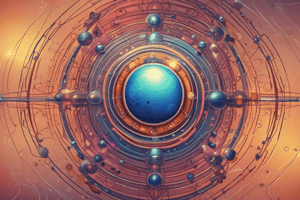Podcast
Questions and Answers
What is the charge of neutrons?
What is the charge of neutrons?
- No charge (correct)
- Variable charge
- Positive
- Negative
What determines the element of an atom?
What determines the element of an atom?
- Number of electrons
- Number of neutrons
- Number of protons (correct)
- Mass of the atom
What is the mass of an electron compared to a proton?
What is the mass of an electron compared to a proton?
- Approximately 1/2
- Approximately 1/1836 (correct)
- Approximately the same
- Approximately 2 times
What is composed of quarks?
What is composed of quarks?
What is the opposite of an electron?
What is the opposite of an electron?
What determines the isotope of an element?
What determines the isotope of an element?
Flashcards are hidden until you start studying
Study Notes
Subatomic Particles
Protons
- Positively charged particles
- Found in the nucleus of an atom
- Have a mass of approximately 1 atomic mass unit (amu)
- Number of protons in an atom determines the element of an atom
Neutrons
- Have no charge
- Found in the nucleus of an atom
- Have a mass of approximately 1 amu
- Number of neutrons in an atom determines the isotope of an element
Electrons
- Negatively charged particles
- Found in energy levels or shells around the nucleus of an atom
- Have a very small mass (approximately 1/1836 that of a proton)
- Number of electrons in an atom is equal to the number of protons, determining the neutral charge of an atom
Other Subatomic Particles
- Quarks: Protons and neutrons are composed of quarks, which are among the smallest known particles in the universe
- Antiparticles: Each subatomic particle has an antiparticle, which has the same mass but opposite charge (e.g., antiproton, antielectron)
Note: These are the main subatomic particles, but there are other particles like muons, neutrinos, and photons that are not directly part of the atomic structure.
Subatomic Particles
- Protons are positively charged particles found in the nucleus of an atom, with a mass of approximately 1 atomic mass unit (amu).
- The number of protons in an atom determines the element of an atom.
- Neutrons have no charge, are found in the nucleus of an atom, and have a mass of approximately 1 amu.
- The number of neutrons in an atom determines the isotope of an element.
- Electrons are negatively charged particles found in energy levels or shells around the nucleus of an atom, with a very small mass (approximately 1/1836 that of a proton).
- The number of electrons in an atom is equal to the number of protons, determining the neutral charge of an atom.
Composition of Protons and Neutrons
- Protons and neutrons are composed of quarks, which are among the smallest known particles in the universe.
Antiparticles
- Each subatomic particle has an antiparticle, which has the same mass but opposite charge (e.g., antiproton, antielectron).
- Other subatomic particles include muons, neutrinos, and photons, which are not directly part of the atomic structure.
Studying That Suits You
Use AI to generate personalized quizzes and flashcards to suit your learning preferences.




